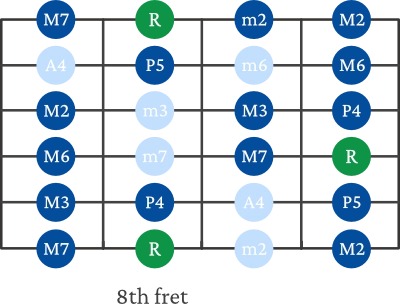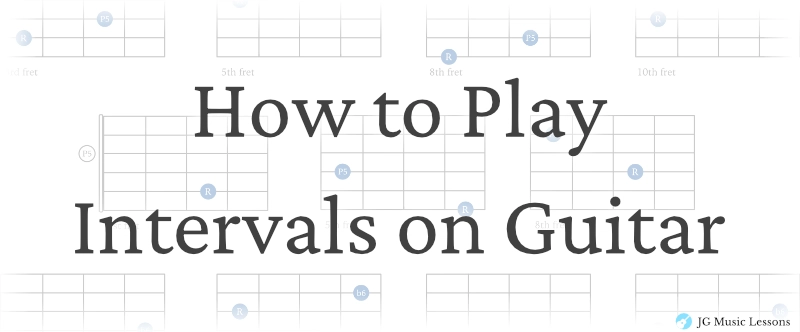Understanding intervals is one of the simplest ways to improve your fretboard knowledge, ear training, and overall confidence when playing. In this lesson, you’ll learn what intervals are, how each one is named, and the most common shapes you’ll use on guitar.
You’ll walk away knowing how intervals shape scales and chords, and how to use them to navigate the fretboard with more clarity.
Learning intervals helps you:
- Understand how scales and chords are built
- Find notes on the fretboard
- Shift between different keys
- Strengthen your ear and musical intuition
✨ This PDF is included in Pro Membership
What is an interval in music?
An interval is simply the distance between any two notes. Each distance has a name, and those names help you understand how music is built and why certain notes work well together.
Here’s a quick reference chart below. Don’t worry if it feels like a lot at first. You’ll see how these intervals actually sound and feel once we get into the playing examples.
Music Intervals Chart
| Interval name | Abbreviation | Distance in steps | Example |
|---|---|---|---|
| Perfect unison or “unison” | P1 | 0 | C to C |
| minor 2nd | m2 | 1 half step | C to C# |
| Major 2nd | M2 | 2 half steps (1 whole step) | C to D |
| minor 3rd | m3 | 3 half steps (1.5 whole steps) | C to Eb |
| Major 3rd | M3 | 4 half steps (2 whole steps) | C to E |
| Perfect 4th | P4 | 5 half steps (2.5 whole steps) | C to F |
| Augmented 4th or diminished 5th (a.k.a. tritone) | A4 or d5 | 6 half steps (3 whole steps) | C to F# or C to Gb |
| Perfect 5th | P5 | 7 half steps (3.5 whole steps) | C to G |
| minor 6th | m6 | 8 half steps (4 whole steps) | C to Ab |
| Major 6th | M6 | 9 half steps (4.5 whole steps) | C to A |
| minor 7th | m7 | 10 half steps (5 whole steps) | C to Bb |
| Major 7th | M7 | 11 half steps (5.5 whole steps) | C to B |
| Perfect octave or “octave” | P8 | 12 half steps (6 whole steps) | C to C |
Interval Shapes on Guitar
Below are the common shapes for each interval type. The visuals stay the same across the neck but you can shift the root note accordingly.
Unison interval on guitar
Here are 3 ways to play the same note C note on the guitar. These notes are considered unison intervals because they are in the same register (meaning one location on the staff).

Unison shape examples

minor 2nd interval examples

minor 2nd shapes

minor 2nd variations

minor 2nd variation shapes

Major 2nd interval examples

Major 2nd shapes

Major 2nd variations examples

Major 2nd variation shapes

minor 3rd interval examples

minor 3rd shapes

minor 3rd interval variation examples

minor 3rd variation shapes

Major 3rd interval examples

Major 3rd shapes

Major 3rd interval variation examples

Major 3rd variation shapes

Perfect 4th interval examples

Perfect 4th shapes

Augmented 4th interval examples

Augmented 4th shapes

Perfect 5th interval examples

Perfect 5th shapes

Perfect 5th interval variation examples

Perfect 5th variation shapes

minor 6th interval examples

minor 6th shapes

minor 6th interval variation examples

minor 6th variation shapes

Major 6th interval examples

Major 6th shapes

minor 7th interval examples

minor 7th shapes

Major 7th interval examples

Major 7th shapes

Octave interval examples

Octave shapes

Applying Intervals to Scales
Intervals give you a visual “map” of the fretboard. Once you know where each interval sits around a root note, you can build any scale quickly.
All intervals in one position

By knowing where your intervals are on the fretboard, you can figure out how to play any scale if you know the formula. For example, the Major scale has the following intervals in relation to the root note: Major 2nd, Major 3rd, Perfect 4th, Perfect 5th, Major 6th, and Major 7th.
Example: Major scale interval formula
In this case, the notes in dark blue circles belong to the Major scale and the notes in light blue are the ones that are omitted.

Using this concept of mapping out intervals will also help you find the notes in triad chords and 7ths chords. This is necessary to know so you can choose the right notes when improvising, regardless of what area you are playing on the fretboard.
This same method works for minor scales, pentatonic scales, blues scales, etc… If you know the formula, you can find the scale anywhere on the neck.
Using Intervals to Build Chords
Intervals also reveal the structure of chords. For example:
- Triads = 1, 3, 5
- 7th chords = 1, 3, 5, 7
- Extensions = 9, 11, 13
Knowing intervals helps you visualize these tones so you can target the right notes when improvising or arranging.
Compound Intervals (Chord Extensions)
Compound intervals are intervals that stretch beyond an octave. You’ll see them often in extended chords or jazz voicings. For example, a Major 10th is simply a Major 3rd moved up an octave.
You may hear these called chord extensions, extended chord tones, or upper extensions. They all refer to the same idea.
Here’s a chart with the most common compound intervals.
Compound Interval Chart
| Interval name | Abbreviation | Distance in steps | Example |
|---|---|---|---|
| Minor 9th | m9 | Half step above octave | C to Db |
| Major 9th | M9 | Whole step above octave | C to D |
| Minor 10th | m10 | 1.5 whole steps above octave | C to Eb |
| Major 10th | M10 | 2 whole steps above octave | C to E |
| Perfect 11th or “11th” | P11 | 2.5 whole steps above octave | C to F |
| Augmented 11th | A11 | 3 whole steps above octave | C to F# |
| Perfect 12th or “12th” | P12 | 3.5 whole steps above octave | C to G |
| minor 13th | m13 | 4 whole steps above octave | C to G# |
| Major 13th | M13 | 4.5 whole steps above octave | C to A |
| minor 14th | m14 | 5 whole steps above octave | C to Bb |
| Major 14th | M14 | 5.5 whole steps above octave | C to B |
| Perfect 15th or double octave | P15 | 6 whole steps above octave | C to C |
Intervals vs Scale Degrees
Intervals describe distance between any two notes.
Scale degrees describe distance from the root of a scale.
They use similar language but for slightly different purposes.
Here is a chart to help you understand the relation between intervals and scale degrees.
| Interval | Scale degree |
|---|---|
| Unison | Root |
| minor 2nd | flat 2 or b2 |
| Major 2nd | 2 |
| minor 3rd | flat 3rd or b3 |
| Major 3rd | 3 |
| Perfect 4th | 4 |
| Augmented 4th | sharp 4 or #4 |
| Perfect 5th | 5 |
| minor 6th | flat 6 or b6 |
| Major 6th | 6 |
| minor 7th | flat 7 or b7 |
| Major 7th | 7 |
| minor 9th | flat 9 or b9 |
| Major 9th | 9 |
| Major 11th | 11 |
| Augmented 11th | sharp 11 or #11 |
| Major 13th | 13 |
Scale degrees also function as chord tones when referring to the notes that make up a chord. These tones define the chord’s quality. For example, a C Major 7 uses the scale degrees 1, 3, 5, and 7 (C, E, G, B).
In short, scale degrees double as chord tones inside chord structures.
Harmonizing a scale with intervals
3rds
Here are examples of harmonizing the C Major scale using different intervals:
🔒 This section is for Pro Members only

You can try these interval examples with different scales. This is one of the best ways to strengthen your ear and understand harmony in real time.
✨ This PDF is included in Pro Membership
Wrapping up
Intervals are one of the most powerful tools for understanding the guitar. The more you can visualize them across the neck, the easier it becomes to:
- Build chords
- Play scales anywhere
- Improvise with intention
- Connect musical ideas smoothly
If you want a practical next step, check out this lesson on how to harmonize a melody using 3rds and 6ths for a real musical application of intervals.
If you enjoyed this lesson, you may also want to learn how to build extended chords on guitar.
📘 Get the free Practice Blueprint: Build better habits and make your progress more consistent. Download the free guide →
All the best,
JG Music Lessons
Start Playing Better, Faster
with Pro Membership! ✨
Get the guidance, tools, and support that keep your progress on track:
🏁 Always know what to practice next. Access the full Guitar Learning Roadmap with lessons in sequence.
🎼 Play songs with confidence. Step-by-step lessons of popular, classical pieces and other styles.
📙 Save time and frustration. Clear PDFs and ebooks that save time so you can focus on playing.
🎟️ Get rewarded for consistency. 2 free downloads every month (a $240+ yearly value).
🎁 Keep costs low while you grow. 50% off all charts, tracks, and posters — up to 75% off bundles.
🚫 Stay focused. Ad-free environment keeps you in the zone.
💬 Get help when you need it. Direct member support to keep you on track.


